The Respiratory Trainer Market is estimated to be valued at USD 609.4 million in 2025 and is projected to reach USD 1244.3 million by 2035, registering a compound annual growth rate (CAGR) of 7.4% over the forecast period.
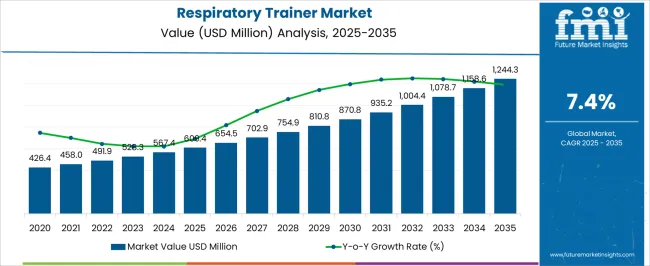
| Metric | Value |
|---|---|
| Respiratory Trainer Market Estimated Value in (2025 E) | USD 609.4 million |
| Respiratory Trainer Market Forecast Value in (2035 F) | USD 1244.3 million |
| Forecast CAGR (2025 to 2035) | 7.4% |
The respiratory trainer market is experiencing robust growth, driven by the rising prevalence of respiratory disorders, particularly in aging populations and individuals exposed to environmental pollutants. Increasing awareness about pulmonary health and the benefits of non-pharmacological interventions is encouraging adoption across clinical and home care settings. The market is further supported by the growing emphasis on preventive healthcare and rehabilitation programs for patients with chronic respiratory conditions.
Technological advancements in respiratory trainers, including the integration of digital monitoring, biofeedback mechanisms, and personalized resistance settings, are enhancing usability and therapeutic efficacy. Expanding clinical evidence demonstrating the benefits of respiratory training in improving lung function, reducing hospitalizations, and supporting recovery from respiratory illnesses is reinforcing adoption across patient populations.
As healthcare providers prioritize patient-centric interventions and home-based care solutions, the respiratory trainer market is positioned for continued growth Increasing investments in medical devices, rising insurance coverage for pulmonary rehabilitation, and integration with telehealth platforms are expected to create additional opportunities for market expansion in the coming years.
The respiratory trainer market is segmented by product type, technique, disease indication, and geographic regions. By product type, respiratory trainer market is divided into Resistance Training Devices and Endurance Training Devices. In terms of technique, respiratory trainer market is classified into Inspiratory Muscle Training, Expiratory Muscle Training, and Others. Based on disease indication, respiratory trainer market is segmented into Chronic Obstructive Pulmonary Disease (COPD), Asthma, and Others. Regionally, the respiratory trainer industry is classified into North America, Latin America, Western Europe, Eastern Europe, Balkan & Baltic Countries, Russia & Belarus, Central Asia, East Asia, South Asia & Pacific, and the Middle East & Africa.
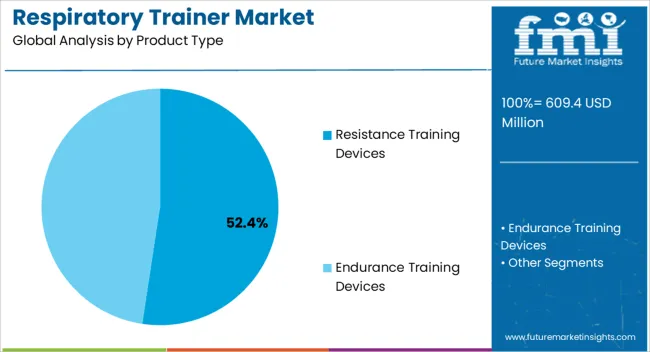
The resistance training devices segment is projected to hold 52.4% of the respiratory trainer market revenue share in 2025, making it the leading product type. Its dominance is being driven by the effectiveness of resistance-based devices in strengthening respiratory muscles and improving overall lung function. These devices offer customizable resistance levels, allowing both patients and healthcare providers to tailor training intensity based on individual needs and disease severity.
The segment is benefiting from strong adoption in rehabilitation centers, clinical practices, and home care applications, where structured inspiratory and expiratory exercises are recommended. Technological enhancements in device ergonomics, digital tracking, and remote monitoring have further increased patient compliance and engagement.
Clinical studies supporting improved outcomes in patients with chronic obstructive pulmonary disease and other respiratory conditions are reinforcing preference for resistance training devices over alternative methods The ease of integration into existing rehabilitation programs and long-term durability of these devices are further strengthening their market position.
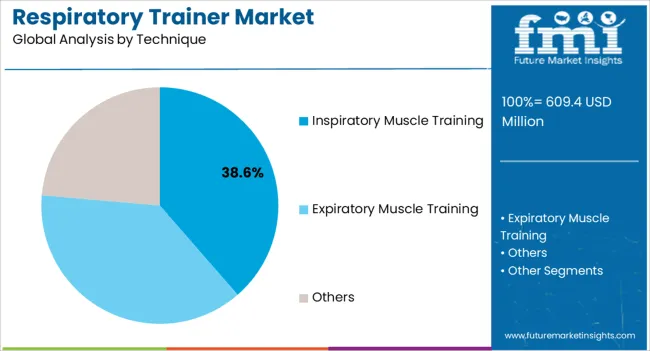
The inspiratory muscle training technique segment is anticipated to account for 38.6% of the respiratory trainer market revenue share in 2025, establishing itself as the leading training method. This segment’s growth is being driven by its clinically proven benefits in enhancing respiratory muscle strength, improving ventilation efficiency, and reducing symptoms such as shortness of breath.
The technique is increasingly recommended for patients with chronic respiratory diseases, post-operative pulmonary rehabilitation, and athletes seeking improved lung capacity. Digital and software-enabled devices allow real-time feedback and performance tracking, enabling precise adjustments to training intensity, which encourages adherence and improves outcomes.
The segment is further supported by growing recognition in clinical guidelines and rehabilitation protocols, where inspiratory muscle training is integrated as a core intervention Adoption is being reinforced by the technique’s ability to deliver measurable improvements in lung function without requiring complex equipment, making it accessible across hospitals, rehabilitation centers, and home care settings.
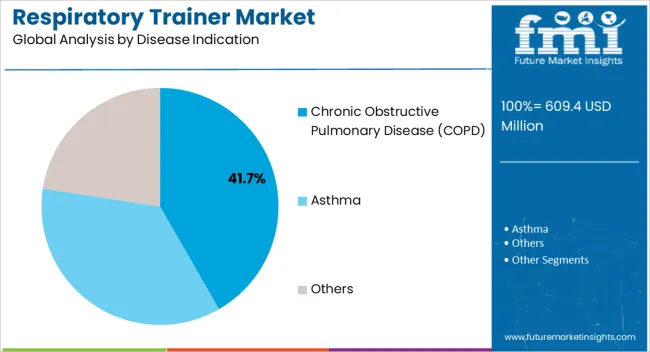
The chronic obstructive pulmonary disease disease indication segment is expected to hold 41.7% of the respiratory trainer market revenue share in 2025, making it the leading disease category. Its dominance is being driven by the high prevalence of COPD globally, particularly among older adults and individuals exposed to air pollution, smoking, and occupational hazards. Respiratory trainers are increasingly being recommended as part of pulmonary rehabilitation programs to enhance lung capacity, improve oxygenation, and reduce the frequency of exacerbations.
The segment is further supported by clinical evidence demonstrating that consistent respiratory training improves exercise tolerance, quality of life, and long-term health outcomes for COPD patients. Integration of digital monitoring and personalized training protocols has strengthened patient adherence and engagement.
Growing awareness among healthcare providers and patients regarding non-pharmacological interventions to complement medical therapy is reinforcing adoption Increasing availability of insurance coverage, coupled with the expansion of home-based rehabilitation solutions, is expected to drive continued growth of this segment in the respiratory trainer market.
Respiratory trainer is commonly known as breathe exerciser is a device that aims to improve function of the respiratory muscles through specific exercises. This device increases the amount one can breathe in and delivers a high mixture of oxygen and air.
Respiratory trainer strengthen the muscles of those who suffer from asthma, bronchitis, emphysema and Chronic Obstructive Pulmonary Disease. There are variety of respiratory trainers are available in the market which include Ultrabreathe, Powerbreathe, PowerLung, and Expand-A-Lung.
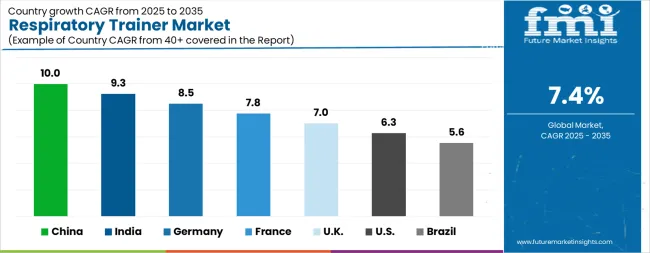
| Country | CAGR |
|---|---|
| China | 10.0% |
| India | 9.3% |
| Germany | 8.5% |
| France | 7.8% |
| UK | 7.0% |
| USA | 6.3% |
| Brazil | 5.6% |
The Respiratory Trainer Market is expected to register a CAGR of 7.4% during the forecast period, exhibiting varied country level momentum. China leads with the highest CAGR of 10.0%, followed by India at 9.3%. Developed markets such as Germany, France, and the UK continue to expand steadily, while the USA is likely to grow at consistent rates. Brazil posts the lowest CAGR at 5.6%, yet still underscores a broadly positive trajectory for the global Respiratory Trainer Market. In 2024, Germany held a dominant revenue in the Western Europe market and is expected to grow with a CAGR of 8.5%. The USA Respiratory Trainer Market is estimated to be valued at USD 228.1 million in 2025 and is anticipated to reach a valuation of USD 419.9 million by 2035. Sales are projected to rise at a CAGR of 6.3% over the forecast period between 2025 and 2035. While Japan and South Korea markets are estimated to be valued at USD 33.2 million and USD 19.9 million respectively in 2025.
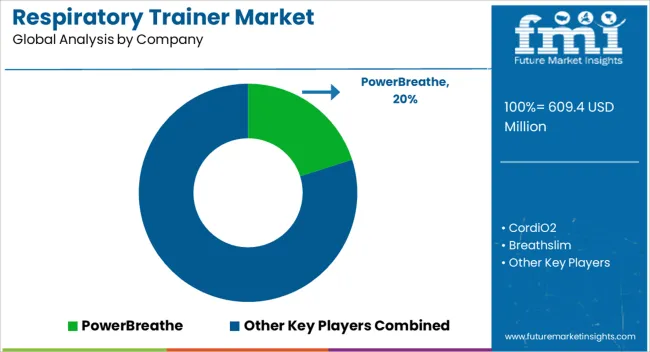
| Item | Value |
|---|---|
| Quantitative Units | USD 609.4 Million |
| Product Type | Resistance Training Devices and Endurance Training Devices |
| Technique | Inspiratory Muscle Training, Expiratory Muscle Training, and Others |
| Disease Indication | Chronic Obstructive Pulmonary Disease (COPD), Asthma, and Others |
| Regions Covered | North America, Europe, Asia-Pacific, Latin America, Middle East & Africa |
| Country Covered | United States, Canada, Germany, France, United Kingdom, China, Japan, India, Brazil, South Africa |
| Key Companies Profiled | PowerBreathe, CordiO2, Breathslim, IngMar Medical, Michigan Instruments, Rescue Critters, and LungTek Ltd |
The global respiratory trainer market is estimated to be valued at USD 609.4 million in 2025.
The market size for the respiratory trainer market is projected to reach USD 1,244.3 million by 2035.
The respiratory trainer market is expected to grow at a 7.4% CAGR between 2025 and 2035.
The key product types in respiratory trainer market are resistance training devices and endurance training devices.
In terms of technique, inspiratory muscle training segment to command 38.6% share in the respiratory trainer market in 2025.






Our Research Products

The "Full Research Suite" delivers actionable market intel, deep dives on markets or technologies, so clients act faster, cut risk, and unlock growth.

The Leaderboard benchmarks and ranks top vendors, classifying them as Established Leaders, Leading Challengers, or Disruptors & Challengers.

Locates where complements amplify value and substitutes erode it, forecasting net impact by horizon

We deliver granular, decision-grade intel: market sizing, 5-year forecasts, pricing, adoption, usage, revenue, and operational KPIs—plus competitor tracking, regulation, and value chains—across 60 countries broadly.

Spot the shifts before they hit your P&L. We track inflection points, adoption curves, pricing moves, and ecosystem plays to show where demand is heading, why it is changing, and what to do next across high-growth markets and disruptive tech

Real-time reads of user behavior. We track shifting priorities, perceptions of today’s and next-gen services, and provider experience, then pace how fast tech moves from trial to adoption, blending buyer, consumer, and channel inputs with social signals (#WhySwitch, #UX).

Partner with our analyst team to build a custom report designed around your business priorities. From analysing market trends to assessing competitors or crafting bespoke datasets, we tailor insights to your needs.
Supplier Intelligence
Discovery & Profiling
Capacity & Footprint
Performance & Risk
Compliance & Governance
Commercial Readiness
Who Supplies Whom
Scorecards & Shortlists
Playbooks & Docs
Category Intelligence
Definition & Scope
Demand & Use Cases
Cost Drivers
Market Structure
Supply Chain Map
Trade & Policy
Operating Norms
Deliverables
Buyer Intelligence
Account Basics
Spend & Scope
Procurement Model
Vendor Requirements
Terms & Policies
Entry Strategy
Pain Points & Triggers
Outputs
Pricing Analysis
Benchmarks
Trends
Should-Cost
Indexation
Landed Cost
Commercial Terms
Deliverables
Brand Analysis
Positioning & Value Prop
Share & Presence
Customer Evidence
Go-to-Market
Digital & Reputation
Compliance & Trust
KPIs & Gaps
Outputs
Full Research Suite comprises of:
Market outlook & trends analysis
Interviews & case studies
Strategic recommendations
Vendor profiles & capabilities analysis
5-year forecasts
8 regions and 60+ country-level data splits
Market segment data splits
12 months of continuous data updates
DELIVERED AS:
PDF EXCEL ONLINE
Respiratory Distress Syndrome Management Market Size and Share Forecast Outlook 2025 to 2035
Respiratory Analysers Market Size and Share Forecast Outlook 2025 to 2035
Respiratory Protective Equipment Market Size and Share Forecast Outlook 2025 to 2035
Respiratory Measurement Devices Market Size and Share Forecast Outlook 2025 to 2035
Respiratory Heaters Market Trends and Forecast 2025 to 2035
Respiratory Pathogen Testing Kits Market Insights - Growth & Forecast 2025 to 2035
Respiratory Inhaler Devices Market Report – Size & Forecast 2025-2035
Understanding Market Share Trends in Respiratory Inhaler Devices
Respiratory Gating Market Analysis – Size, Share & Forecast 2025-2035
Respiratory Device Market Insights – Growth & Forecast 2024-2034
Global Respiratory Biologics Market Analysis – Size, Share & Forecast 2024-2034
Home Respiratory Therapy Market – Growth & Forecast 2025 to 2035
Japan Respiratory Inhaler Devices Market Size and Share Forecast Outlook 2025 to 2035
Swine Respiratory Diseases Treatment Market Analysis - Size and Share Forecast Outlook 2025 to 2035
Human RSV Treatment Market Insights - Innovations & Forecast 2025 to 2035
Upper Respiratory Tract Infection Treatment Market
Germany Respiratory Inhaler Devices Market Insights – Demand, Trends & Outlook 2025-2035
Chronic Respiratory Diseases Treatment Market
Molecular Respiratory Panels Market Size and Share Forecast Outlook 2025 to 2035
Unit-Dose Respiratory Medications Market

Thank you!
You will receive an email from our Business Development Manager. Please be sure to check your SPAM/JUNK folder too.
Chat With
MaRIA